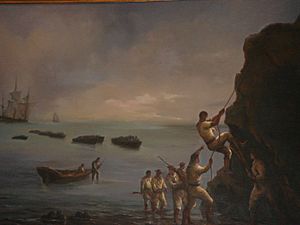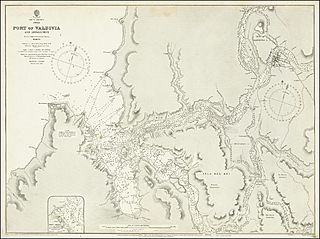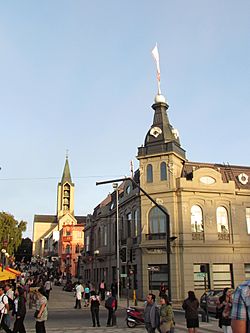Capture of Valdivia facts for kids
Quick facts for kids Capture of Valdivia |
|||||||
|---|---|---|---|---|---|---|---|
| Part of the Chilean War of Independence | |||||||
 Painting of the climbing of La Aguada del Inglés in the Chilean naval and maritime museum |
|||||||
|
|||||||
| Belligerents | |||||||
| Commanders and leaders | |||||||
| Thomas Cochrane Jorge Beauchef |
Manuel Montoya Fausto del Hoyo |
||||||
| Strength | |||||||
| 310 | 1,606 110 24-pounder cannons |
||||||
| Casualties and losses | |||||||
| 7 killed and 25 wounded or 39 killed and wounded 1 brigantine |
~100 killed 106 prisoners |
||||||
The Capture of Valdivia was a key battle during the Chilean War of Independence. It took place on February 3 and 4, 1820. This fight was between the Royalist forces, who supported the King of Spain, and the Patriot forces, who wanted Chile to be independent.
The battle was fought for control of the city of Valdivia and its very strong harbor. The Patriots, led by Thomas Cochrane and Jorge Beauchef, won a big victory. They took control of the forts around Valdivia with a clever surprise attack at night. This win was very important for Chile's independence.
Contents
Why Valdivia Was Important

Even after Chile won a major battle at Battle of Maipú in 1818, the Spanish Royalists still held some important places. These included Talcahuano, Valdivia, and Chiloé. The Patriots saw these areas as a threat to their new country, the Republic of Chile.
Valdivia was especially important. It was a strong naval base where Spanish ships could land. From there, they could try to stop Chile's independence. Valdivia could also supply Spanish guerilla fighters who were causing trouble for the Patriots.
The city of Valdivia itself had mixed feelings. Some families supported the Patriots, while others supported the Royalists. In 1811, Patriots briefly took control of Valdivia. But Royalists took it back in 1812, and it stayed under their control until this battle.
Strong Forts Protecting Valdivia
Valdivia was known for having the strongest defenses in southern Viceroyalty of Peru. Even Thomas Cochrane, the Patriot leader, knew how tough it would be to attack. The defenses were a system of many forts and batteries (groups of cannons).
On the south side of the harbor were three main forts: Fort Aguada del Inglés, Fort San Carlos, and Fort Amargos. Castillo de Corral was a large fort with strong walls. These forts had powerful cannons, some that could even heat cannonballs to make them more destructive. Fort Aguada del Inglés was built to stop enemies from landing on the beaches.
On the north side, there was Fort Niebla, a stone-walled fort. It could fire cannons across the water with Fort Amargos. Mancera Island, in the middle of the harbor, also had a small group of soldiers and cannons. In total, there were 15 defensive spots with 110 cannons protecting Valdivia.
Planning the Attack
Cochrane had tried to capture another Spanish fort in Peru but failed. So, he decided to attack Valdivia instead. This wasn't a sudden idea; he had been planning it for a while.
On January 17, Cochrane's small Chilean fleet arrived near Valdivia. He secretly entered Corral Bay in a small boat called a chalupa. He captured some Spanish soldiers and learned that a Spanish ship, the San Telmo, had not yet arrived. The next day, the Spanish on land became suspicious and fired at Cochrane's boat.
On January 19, Cochrane's fleet captured a Spanish ship called Potrillo. This ship was carrying valuable items like silver, gunpowder, and wood. It also had a useful map of the port.
Cochrane returned to Talcahuano in January 1820. He asked for more soldiers to attack Valdivia. He kept his true plans a secret from most Patriot leaders. He even sent a misleading letter to trick them, but told his real plan to Bernardo O'Higgins, a key Chilean leader.
On January 28, Cochrane set sail for Valdivia with three ships: O'Higgins, Intrépido, and Moctezuma.
The Daring Battle Begins
Cochrane knew the forts were strong. So, he decided on a surprise attack from land. His plan was to pretend his ships were part of the Spanish San Telmo convoy. This trick worked for a short time. But then the Spanish saw a hidden landing boat and started firing.
Landing and First Attack
About 250 soldiers led by Jorge Beauchef and 60 by Guillermo Miller landed on a small beach at Aguada del Inglés. Around 70 to 80 Spanish soldiers came down from the fort to fight them with bayonets. But the Patriot ships fired their cannons, forcing the Spanish to retreat.
Around 6 PM, Beauchef ordered his troops to advance on Fort Inglés. The Patriots moved forward, but then came under heavy fire from the fort's cannons and muskets. Luckily, the darkness of the night and the nearby forest made it hard for the Spanish to aim. A group of 70 Patriots secretly went around the fort. Around 9 PM, they started climbing the walls. Even though the first two climbers were killed, the Patriots eventually got inside. The Spanish defenders panicked when they were attacked from both outside and inside, and they ran away from the fort.
Taking More Forts
Beauchef quickly continued his attack. He captured Fort San Carlos and Castillo de Amargos, as well as the Chorocamayo and Barros cannon batteries. The Spanish commander at San Carlos couldn't stop his soldiers from fleeing. The cannons in this fort were useless because they were all pointed towards the sea, not towards the land where the Patriots were attacking.
The Patriots were very confident. They rushed towards the next Spanish position, Castillo de Corral. This was the last fort on the southern side of the bay. About 200 Spanish soldiers, many of whom had fled from other forts, defended Castillo de Corral. The Patriots attacked from three sides, making the Spanish think there were many more attackers. The fight was fierce and disorganized. The fort's walls, meant to protect, became a trap for the Royalists. Eventually, the Spanish leaders surrendered.
Colonel Manuel Montoya, the main Spanish commander for Valdivia, stayed in the city, far from the fighting. He sent 100 men to reinforce the forts, but it was too late.
Royalists Retreat
After taking the southern forts, Cochrane stopped the fighting for the night. The next morning, the ships Moctezuma and Intrépido entered the bay. They faced cannon fire from Castillo de Mancera and Castillo de Niebla. The Intrépido was damaged, but the Moctezuma managed to silence some of the Spanish cannons. These ships reached Corral port by 8 AM.
Cochrane expected a harder fight for the remaining forts because the element of surprise was gone. He planned to use 200 soldiers for this next attack.
Meanwhile, the Spanish reinforcements arrived at Niebla. But the Spanish soldiers were very discouraged. When Cochrane's 200 men approached Niebla, the Spanish soldiers at Castillo de Niebla and Mancera Island quickly retreated. They used any small boats they could find to go upriver to Valdivia. The sight of Cochrane's ship O'Higgins in the morning, even though it was mostly empty, might have made the Royalists think a much larger Patriot force was coming.
After the battle, the ship Intrépido ran aground and was lost because its hull (bottom part) was in bad condition.
Taking Control of Valdivia
In Valdivia, Colonel Montoya secretly prepared to leave the city. Soldiers who had fled the forts arrived in the city, telling exaggerated stories about the size of the Patriot army. A meeting of war leaders decided to evacuate Valdivia and go to Chiloé. This decision saved Valdivia from becoming a battlefield.
However, a difficult situation developed in the city. Royalist soldiers took things from the homes and shops of local Patriots. Some soldiers even stayed behind to get more items. After the last Royalist soldiers left, local Valdivians who supported the Patriots began to take things from the homes of Royalists. Some wealthy Royalist families had to leave the city for their country homes. Both Patriot and Royalist civilians were harmed during these events.
Important families in Valdivia met to discuss the problem. A woman named María de los Ángeles de la Guarda took the lead. She sent a message to the Patriot forces. Cochrane received the message in Corral. He sent Beauchef with 100 soldiers to Valdivia. Beauchef promised that no one would be punished for being a Royalist and that those who had fled could return. He also said that private property would be respected. Cochrane's fair approach helped the Patriots gain the trust of the local Royalists.
On Sunday, February 6, Cochrane landed in Valdivia with his troops. Important people from the city welcomed him. Cochrane walked from the harbor to the main square. The street he walked on was later renamed Paseo Libertad (Liberty Walk). Soon after, Vicente Gómez Lorca was chosen as the new Governor of Valdivia.
What Happened Next
Cochrane took a Spanish ship called Dolores. He used it for an expedition to the Chiloé Archipelago, which was still controlled by Royalists south of Valdivia. However, Lord Cochrane was not successful in capturing Chiloé. Before returning north, he went back to Valdivia to collect valuable items. He took weapons, gunpowder, silver objects from churches, and other valuables. The Dolores ship and its cargo were the most valuable things he took. It was later sold in Valparaíso.
Cochrane thought about destroying the forts, but he didn't.
Cochrane left Valdivia on February 28. Jorge Beauchef stayed in Valdivia. He soon left by land with 200 soldiers to secure the area between Valdivia and Chiloé for the Republic. Beauchef successfully secured Los Llanos and Osorno. He also stopped a Royalist counter-attack at the Battle of El Toro.
By October 1820, the Patriots faced some problems with Royalist fighters near Concepción. Beauchef had left Valdivia. There were rumors that the Governor of Chiloé, Antonio de Quintanilla, would invade Valdivia. This invasion never happened, but the Royalists continued to resist in Chiloé until 1826.
The priests of the Franciscan missions around Valdivia supported the Royalist cause. Over time, they were replaced by priests who supported the Republic of Chile.
Images for kids
See also
 In Spanish: Toma de Valdivia para niños
In Spanish: Toma de Valdivia para niños





